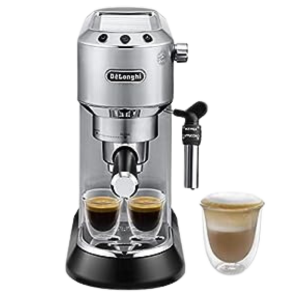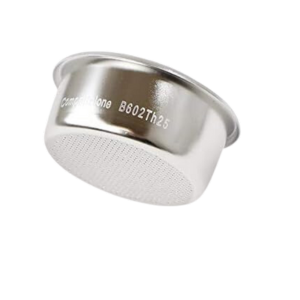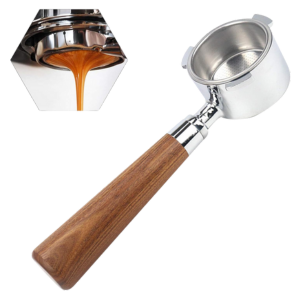By: The Caffeinated Gear Team

Looking for a genuine, hands-on review of the DeLonghi Dedica EC685? Our team of certified baristas has put this compact espresso machine through its paces in our testing lab and daily use. We’ll share our professional insights and practical tips to help you get exceptional coffee from this popular machine.
Not only will we give you our candid assessment based on extensive testing, but we’ll also reveal some clever adjustments that can dramatically improve your coffee quality. Let’s dive into everything you need to know about the DeLonghi Dedica.
As leaders in coffee education and equipment testing, we bring together decades of combined experience across our team of certified baristas, roasters, and industry professionals. Our expertise spans professional cafe operations to home brewing, allowing us to evaluate equipment from multiple perspectives.
When we first started exploring home espresso machines back in 2015, we noticed a significant gap between marketing claims and real-world performance. This inspired us to create detailed, experience-based reviews that go beyond basic specs to help fellow coffee enthusiasts make informed decisions.
Today, our viewers and readers trust us because we focus on what matters most – helping you find the right equipment for your specific needs and coffee preferences.
Our reviews stand out because we prioritise practical insights over technical specifications. While other reviews might fixate on features like cup warmers or water tank capacity, we dig deeper to determine whether a machine truly matches your brewing style and expectations.
We thoroughly test each coffee machine (and coffee grinder) to provide real-world insights that help you make the right choice for your kitchen.

Before diving into the specifics, let’s determine if this style of coffee machine matches your needs.
The DeLonghi Dedica is specifically designed as an espresso machine. This distinction matters because different coffee machines serve different purposes. For instance, if you prefer filter coffee, you’ll want to look at dedicated filter coffee machines instead.
However, if you’re keen on espresso and espresso-based drinks like cappuccino, latte, flat white, Americano, or lungo, then you’re on the right track with the Dedica.
It’s important to understand that the DeLonghi Dedica falls into the semi-automatic traditional espresso machine category. This means it offers a different experience compared to bean-to-cup machines.
Bean-to-cup machines integrate grinding and typically handle most of the brewing process automatically. Standard models manage the coffee preparation while leaving milk steaming to you, while super-automatic versions handle both coffee and milk preparation with minimal input.
If convenience is your primary concern, and you’re not interested in developing barista skills to perfect your shots, we’d recommend considering a bean-to-cup machine instead.
However, if you’re drawn to the authentic espresso-making experience, keep reading – the DeLonghi Dedica might be exactly what you’re looking for.
Understanding the concept of being a home barista is crucial when considering a traditional espresso machine like the Dedica.
A home barista develops the skills to create cafe-quality coffee in their own kitchen. Unlike using a Nespresso machine or bean-to-cup system, traditional espresso machines require some technical knowledge and practice.
That said, entry-level machines with pressurised baskets (like the Dedica) can produce decent results with less expertise. If you’re satisfied with good everyday espresso, you might find the learning curve quite manageable. However, if you’re pursuing excellence in your coffee, you’ll want to explore unpressurised baskets and develop more advanced skills.
There’s a significant distinction between domestic espresso machines (typically £100-£200) and home barista machines (£400-£500+). The price difference reflects fundamental technical variations.
Standard domestic machines typically feature:
For those interested in the technical details, let’s explore these features further. If you’d prefer to skip the technical discussion, jump ahead to the “DeLonghi Dedica Coffee Machine Review” section below.
Pressure measurement in bars directly impacts espresso extraction. While commercial machines typically operate at 9 bars (around 130 PSI), most budget machines run at 15 bars (nearly 220 PSI). Despite marketing claims, this higher pressure isn’t beneficial – it’s simply more economical to manufacture without pressure regulation.
Regarding heating systems, most affordable machines use thermoblocks rather than brew boilers. Think of thermoblocks as on-demand water heaters, similar to combi boilers versus traditional water tanks.
It’s worth noting the distinction between thermoblocks and thermocoils. While some premium machines, including certain Sage machines, use thermocoils for better performance and durability, most budget-friendly machines stick with thermoblocks.
Now, let’s return our focus to the Dedica!
Solenoid valves, found in professional and high-end home machines, help create dry, easily removable coffee pucks by releasing excess moisture after brewing. Budget machines typically omit this feature.
For more details about professional-grade equipment, see:
Pressurised portafilter baskets are standard in budget machines, differing from traditional filter baskets.

A filter basket holds ground coffee within the portafilter, which locks into the group head for brewing. Traditional baskets require proper espresso grinders and technique, while pressurised baskets work with pre-ground coffee or less precise grinders.
While pressurised baskets can create visually appealing crema, they don’t always deliver the same depth of flavour as traditional baskets.
If you’re now considering a entry-level professional machine instead, we recommend checking out:
For a detailed comparison of these popular entry-level professional machines, watch our comprehensive guide:
If you’ve read this far, we assume you’re interested in a traditional espresso machine rather than a bean-to-cup system, and you’re working with a budget of around £200.
Based on our extensive testing, we believe the Dedica EC685 – the latest Dedica model – represents one of the best values in this price range, unless you’re considering the used market.
Let’s examine our findings in detail.
14.9 x 33 x 30.3 cm. 4.2 Kg
Our testing revealed the Dedica to be surprisingly capable. Despite being a budget-friendly pressurised basket machine, it offers impressive performance for its class.
While we believe the full retail price could be more competitive, the machine frequently goes on sale, offering better value. At discounted prices, it represents a solid investment.
The Dedica has several noteworthy features. Perhaps most importantly, while you can’t modify the pump pressure, you can easily upgrade to a standard basket.
As demonstrated in our video above, we successfully fitted a bottomless portafilter with a standard basket – a simple £20 modification that significantly improves brewing potential.
You could save money by just replacing the basket, though this might require minor adjustments. We found the bottomless portafilter route more straightforward, plus it provides valuable visual feedback about extraction quality.
The 15-bar pressure does make channeling more likely, requiring careful attention to puck preparation. However, the Dedica’s automatic pre-infusion feature helps mitigate this issue somewhat.
While we couldn’t confirm whether this truly delivers low-pressure pre-infusion or simply pulses water at full pressure, it does help promote more even extraction.
One common issue we often hear about from our community is channelling—a frustrating problem that occurs during espresso extraction. When water creates paths of least resistance through your coffee puck, it results in uneven extraction and, frankly, disappointing espresso.
A brilliant feature we discovered during our testing is the adjustable brew temperature. It’s quite rare to find this capability in machines at this price point, offering you the kind of control typically reserved for much pricier equipment.
Speaking of pleasant surprises, we were genuinely impressed by the Panarello steam wand’s performance. Now, if you’re familiar with espresso machines, you’ll know these attachments (those thick sheaths covering the steam wand) often get a bad rap for producing only thick, bubbly foam. While that might suit some coffee drinks, it’s not ideal for silky microfoam.
Typically, we’d suggest removing the Panarello attachment on most machines to use the bare steam pipe. With the DeLonghi Dedica, while you can do this (just remember to secure the rubber pipe with a cable tie to prevent any hot milk accidents), we found the Panarello attachment itself can actually produce remarkably good milk texture.
Here’s our tested technique: Begin with the Panarello set to “hot water” for several seconds while creating a whirlpool in your milk pitcher. Switch to the “cappuccino” setting to incorporate air, maintaining this for roughly 40 seconds depending on your desired foam consistency. Finally, return to the “hot water” setting until you reach your target temperature.
The results? Perfectly textured milk that’s absolutely suitable for latte art. We demonstrate this in our tutorial below.
This innovative approach significantly reduces the learning curve for achieving professional-quality milk texture without requiring extensive barista training.
Whether you’re a new Dedica owner or considering purchasing one, we’ve compiled our comprehensive guide to achieving the best possible results with your machine. After months of testing and experimenting, here are our professional recommendations.
The foundation of exceptional espresso lies in using high-quality coffee beans. Supermarket coffee, while convenient, often falls short of providing the best experience. Most mass-market beans are past their prime and frequently over-roasted to maintain consistency across large batches. For more detailed guidance on sourcing excellent beans.
Your journey to exceptional espresso begins with freshly roasted high quality coffee beans.
Quick note: If you’re content using the pressurised baskets included with your Dedica and aren’t looking to dive deeper into the world of home espresso, feel free to skip the next 9 tips and jump straight to our conclusion.
Burr grinders are essential for espresso – there’s simply no substitute, so please set aside any thoughts of using a blade grinder.
While budget options like the DeLonghi KG79 or Krups Expert might seem tempting, we’ve found through extensive testing that they won’t unlock your Dedica’s full potential. We recommend stepping up to the Iberital MC2, Lelit Fred, Sage Dose Control Pro, Sage smart grinder pro, Baratza Sette or one of the excellent Eureka Mignon grinders.
These brilliant machines range from £125 to £300 new, but don’t overlook the second-hand market on eBay – quality grinders often appear at fantastic prices.
For those exploring used options, we’re particularly keen on ex-commercial grinders, especially the Mazzer Super Jolly. These professional-grade machines are built like tanks. While they typically come with a doser (which is excessive for home use), there are brilliant modifications available to convert them for doserless or single-dose operation.
For more detailed guidance, check out:
As we mentioned earlier, standard baskets are crucial for achieving the finest espresso your Dedica can produce.

We’ve had brilliant results with a competition-grade basket like this one. You’ll need to slightly modify your Delonghi portafilter to accommodate it – this involves carefully bending the basket’s lip with pliers and hammering it to shape.
Alternatively, we recommend the hassle-free route of a bottomless portafilter like this one (which we use in our test kitchen). It comes with a standard basket and requires no DIY skills.

A quick heads-up: the standard basket included with the bottomless portafilter might not match the precision of the IMS competition basket mentioned above. For absolute peak performance, you might want to either modify the IMS basket to fit your Delonghi portafilter or pair the bottomless portafilter with the IMS basket.
We’re currently testing whether the IMS basket fits the bottomless portafilter without modifications and will update our findings soon.
Another creative option is to convert your existing Delonghi portafilter into a bottomless version by carefully cutting away the bottom portion to accommodate the IMS basket.
Dialling in is the crucial process of finding the perfect grind size for your specific beans.
In our testing lab, we typically aim for a 1:2 ratio – for instance, with 14g of ground coffee in a double basket, we look for 28g of espresso in roughly 28-32 seconds. However, we encourage you to experiment with different ratios and recipes to find your sweet spot.
If your shot flows too quickly, adjust your grinder finer. If it’s too slow, go slightly coarser.
Our pro tip: When starting out, buy your coffee in bulk – either 1kg bags or multiple 250g bags from the same roaster and batch. This gives you plenty of beans to perfect your technique. Nothing’s more frustrating than dialling in perfectly only to run out of beans! Remember, each new bag requires fresh dialling in.
Precise measurements are non-negotiable – you’ll need reliable brew scales to weigh both your ground coffee and the resulting espresso.
We’ve tested numerous scales, and the Timemore black mirror stands out as our top pick in the mid-range category.
If that’s beyond your budget, we’ve also had good results with these. While they’re not as responsive and require batteries instead of USB charging, they’ll get the job done at a friendlier price point.
Remember our earlier discussion about preventing channelling? Proper puck preparation is your best defence.
This crucial process involves three key steps: dosing, distribution, and tamping.
Dosing means using the correct amount of coffee for your basket. While we’re still experimenting with various combinations, most standard baskets work best with around 14g. The IMS competition basket we mentioned is specifically designed for a 14g dose.
Distribution ensures even coffee placement throughout the basket. We’re big fans of the WDT method – using a fine needle or straightened paperclip to break up clumps in the ground coffee. While you can spend ages with a single tool, we recommend a multi-pronged approach for efficiency.
While there are premium tools available, we’ve found brilliant results with a modified keycap puller like this – just snip off the ends. Alternatively, try mounting several needles in a cork. We’ll be sharing a detailed video guide on this soon.
Through countless shots pulled in our testing, we’ve learned that tamping level is far more crucial than pressure.
Focus on creating a perfectly level coffee bed rather than hitting a specific pressure. Just maintain a consistent, comfortable force that you can replicate shot after shot.
After your careful distribution and tamping, treat your portafilter gently. Banging it while locking into the group head can crack your carefully prepared puck, guaranteeing channelling issues.
Particularly for light to medium roasts (though less crucial for darker beans), we recommend using the Dedica’s highest temperature setting.
Access this by holding the steam button for 10 seconds to enter settings mode. Press the single shot button (the lights will flash), then use the steam button to select high temperature. For reference: single shot selects low temp, double shot selects medium.
Our testing shows that proper temperature management is crucial. Before each shot, run at least one double shot worth of water through the portafilter – we actually recommend two for optimal results.
Pro tip: Position your cup on the drip tray during this flush to pre-warm it.
With a bottomless portafilter, visual feedback becomes your best friend.
Watch out for “spurting” or multiple streams – these are clear signs of channelling.
After extensive testing in our coffee lab, we’re convinced the DeLonghi Dedica offers exceptional value for money in its price range.
For coffee enthusiasts starting their home barista journey, this machine stands out as a brilliant choice when compared to other new machines at this price point.
Whether you’re planning to use the included pressurised baskets for convenience, or you’re ready to pair it with a quality espresso grinder and standard basket for more control, the Dedica proves remarkably versatile.
© 2025 Caffeinated Gear.